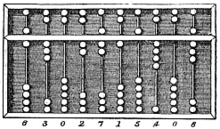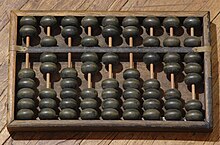
Back Suanpan Catalan Suanpan Spanish Suanpan Estonian سوانپان Persian Suanpan French Suanpan Italian Suanpan Malay Suanpan NB Suanpan Polish Suanpan Portuguese





The suanpan (simplified Chinese: 算盘; traditional Chinese: 算盤; pinyin: suànpán), also spelled suan pan or souanpan[1][2]) is an abacus of Chinese origin, earliest first known written documentation of the Chinese abacus dates to the 2nd century BCE during the Han dynasty, and later, described in a 190 CE book of the Eastern Han dynasty, namely Supplementary Notes on the Art of Figures written by Xu Yue. However, the exact design of this suanpan is not known.[3][4] Usually, a suanpan is about 20 cm (8 in) tall and it comes in various widths depending on the application. It usually has more than seven rods. There are two beads on each rod in the upper deck and five beads on each rod in the bottom deck. The beads are usually rounded and made of a hardwood. The beads are counted by moving them up or down towards the beam. The suanpan can be reset to the starting position instantly by a quick jerk around the horizontal axis to spin all the beads away from the horizontal beam at the center.
Suanpans can be used for functions other than counting. Unlike the simple counting board used in elementary schools, very efficient suanpan techniques have been developed to do multiplication, division, addition, subtraction, square root and cube root operations at high speed.
The modern suanpan has 4+1 beads, colored beads to indicate position and a clear-all button. When the clear-all button is pressed, two mechanical levers push the top row beads to the top position and the bottom row beads to the bottom position, thus clearing all numbers to zero. This replaces clearing the beads by hand, or quickly rotating the suanpan around its horizontal center line to clear the beads by centrifugal force.
- ^ Schmid, Hermann (1974). Decimal Computation (1 ed.). Binghamton, New York, USA: John Wiley & Sons. ISBN 0-471-76180-X.
- ^ Schmid, Hermann (1983) [1974]. Decimal Computation (1 (reprint) ed.). Malabar, Florida, USA: Robert E. Krieger Publishing Company. ISBN 0-89874-318-4.
- ^ Ifrah 2001, p. 17
- ^ Peng Yoke Ho, page 71
© MMXXIII Rich X Search. We shall prevail. All rights reserved. Rich X Search